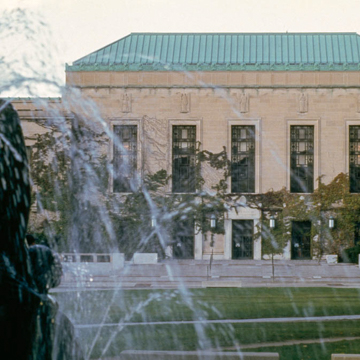You are here
Horace H. Rackham Building (Horace H. Rackham School of Graduate Studies)
The Rackham Building anchors the north axis of the Ingalls Campus Mall opposite the Harlan Hatcher Graduate Library. Completed during a period of increasing demand for graduate study, the austerely modern yet classicist building is a monument to the university's graduate programs, and a memorial to Rackham, very characteristic of the 1930s. Rackham (1858–1933), a lawyer and an original stockholder in the Ford Motor Company, was an alumnus of the university. The building was the gift of the Horace H. Rackham and Mary A. Rackham Fund.
The restrained, symmetrical limestone building has a central block with wings and is set back and terraced. A wide staircase leads to the main block, which is punctured by five tall rectangular windows topped by narrow, stylized relief panels and crowned with a copper-clad hipped roof. Three bronze and glass doors open onto a spacious entrance hall richly finished with plastered walls above a black marble base and a green and purple gray slate floor and with a blue-green beamed ceiling stenciled in Pompeian red, tan, and gold. Off the entrance hall is a two-story, semicircular lecture hall that seats 1,200. The building's upper floors contain study, music, exhibition, lecture and meeting rooms, and lounges.
Restoration and renovation aspired to create a twenty-first-century state-of-the-art learning and working environment, while maintaining and respecting the building's historic relevance and beauty.
Writing Credits
If SAH Archipedia has been useful to you, please consider supporting it.
SAH Archipedia tells the story of the United States through its buildings, landscapes, and cities. This freely available resource empowers the public with authoritative knowledge that deepens their understanding and appreciation of the built environment. But the Society of Architectural Historians, which created SAH Archipedia with University of Virginia Press, needs your support to maintain the high-caliber research, writing, photography, cartography, editing, design, and programming that make SAH Archipedia a trusted online resource available to all who value the history of place, heritage tourism, and learning.


